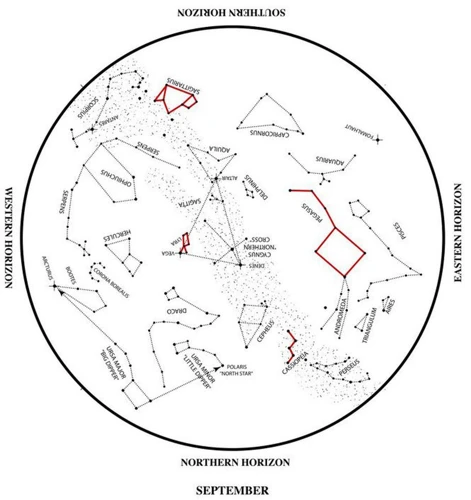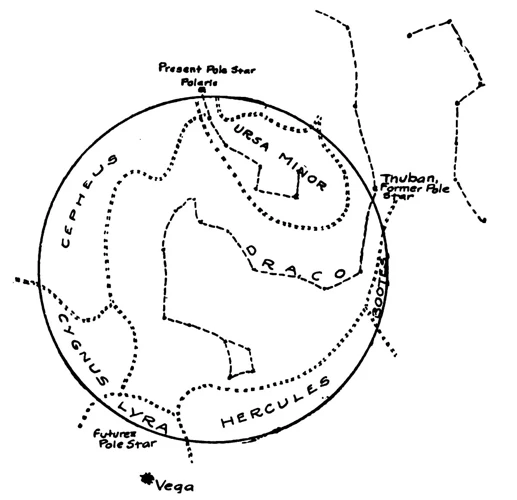Unlocking the Secrets of Polaris: The Guiding Light of the Night Sky
For centuries, the shimmering stars have fascinated and captivated the hearts and minds of people across the globe. Among these celestial jewels, Polaris, the North Star, stands out as a beacon of guidance and inspiration. From aiding ancient travelers in their journeys across vast oceans to igniting mythical tales passed down through generations, Polaris has a rich and intriguing history. In this article, we delve into the role of Polaris in navigation and mythology, exploring its importance in our modern world and its enduring significance in popular culture. Join us as we unlock the mysteries and unveil the breathtaking allure of Polaris, the guardian of the night sky.
Contents
- Polaris and Navigation
- Polaris in Mythology
- Modern Significance of Polaris
- Conclusion
-
Frequently Asked Questions
- How does Polaris aid in navigation?
- Why is Polaris referred to as the North Star?
- Is Polaris the brightest star in the sky?
- How can you find Polaris in the night sky?
- Does Polaris ever move in the sky?
- Why was Polaris important to ancient seafarers?
- Are there any myths or legends associated with Polaris?
- Can you see Polaris from the southern hemisphere?
- How is Polaris used in modern navigation?
- Is Polaris mentioned in any popular culture references?
- References
-
Frequently Asked Questions
- Why is Polaris called the North Star?
- How does Polaris help sailors navigate on the open seas?
- Can Polaris be seen from the Southern Hemisphere?
- What happens if Polaris is not visible due to obstructed view?
- Is Polaris the brightest star in the night sky?
- Why is Polaris sometimes referred to as the Pole Star?
- Are there other stars that can be used for navigation?
- What are some common myths or folklore associated with Polaris?
- Can Polaris be used to navigate on land?
- Is Polaris always directly overhead at the North Pole?
- References
- Read More

Polaris, the North Star, has long served as a crucial navigational tool for sailors, explorers, and travelers alike. Its unique position almost directly above the Earth’s North Pole has made it a reliable reference point for determining direction, especially in the northern hemisphere. One of the key reasons why Polaris is so important in navigation is its stability. Unlike other stars that appear to move across the sky, Polaris remains relatively fixed, acting as a steadfast guide even during long journeys. Sailors would use various methods, such as aligning their ships with Polaris or utilizing celestial navigation techniques, to determine their latitude and stay on course. In fact, the North Star’s importance in navigation can be traced back thousands of years. Ancient seafaring civilizations, including the Phoenicians and the Polynesians, recognized the significance of Polaris in their voyages across vast oceans. Its unwavering presence provided a sense of security, enabling mariners to navigate with confidence. To learn more about ancient navigation techniques and how Polaris shaped the course of history, check out our fascinating article on the Mesopotamian Zodiac and the Pisces Constellation.
The Importance of Polaris
The importance of Polaris, also known as the North Star, cannot be overstated in the world of navigation. Throughout history, navigators have relied on Polaris as a dependable and constant reference point in the night sky. One of the key reasons why Polaris is so vital is its position almost directly above the Earth’s North Pole. This unique location allows it to remain relatively fixed while other stars appear to move across the sky due to Earth’s rotation. Sailors and explorers have used this stability to their advantage, aligning their routes and measuring their latitude based on the position of Polaris. Its unwavering presence provides reassurance and helps navigate through vast expanses of the open sea or uncharted territories. For those navigating in the Northern Hemisphere, Polaris can be relied upon to indicate true north, making it an invaluable tool for charting a course. If you’re fascinated by ancient civilizations and how they interpreted celestial bodies, you may be interested in exploring our article on the unveiling of sacred Mayan symbols and meanings.
Polaris, the North Star, plays a vital role in navigation by providing a consistent reference point for determining direction. Here are some key ways in which Polaris aids navigators:
- Latitude Determination: Polaris sits almost directly above the Earth’s North Pole. This means that observers in the Northern Hemisphere can use Polaris to determine their latitude. By measuring the angle between the horizon and Polaris, navigators can calculate their position on the Earth’s surface. The higher Polaris appears, the farther north the observer is located.
- Steadfast Guide: One of the most valuable aspects of Polaris is its stability in the night sky. While other stars appear to move throughout the night due to the Earth’s rotation, Polaris remains almost fixed. This makes it an excellent point of reference for long journeys. Sailors and travelers can use Polaris as a guiding star, aligning their course with this reliable celestial landmark.
- Shortest Route: When traveling in the Northern Hemisphere, Polaris can assist in finding the shortest route between two destinations. By keeping Polaris at a constant bearing, navigators can move along a meridian, a line of longitude that runs through the North Pole. Following a meridian helps travelers maintain a straight path, ensuring they do not drift off course.
- Backup for other Navigation Methods: Polaris acts as a backup or supplemental tool for other navigation techniques. In addition to using Polaris, sailors and navigators would also rely on instruments such as compasses, charts, and astrolabes. However, if these instruments were to fail or become unreliable, Polaris would remain a steady reference point.
It is fascinating to explore how ancient civilizations utilized Polaris for navigation. For example, Native American tribes, including the Navajo, believed that Polaris guided their medicine men and women during their spiritual journeys. To learn more about the role of Polaris in Native American mythology, delve into our captivating article on the significance of medicine men and women in Native American mythology.
Polaris in Mythology

Throughout history, Polaris, the North Star, has held a significant place in the rich tapestry of mythology. Ancient civilizations looked up at the night sky and wove captivating tales around this guiding celestial light. Polaris was often associated with various deities and mythical figures, symbolizing guidance, steadfastness, and divine presence. In Greek mythology, for example, the North Star represented the celestial axis around which the heavens revolved. It was believed to be the dwelling place of the gods and a celestial point of reference for mortals. In Norse mythology, Polaris was associated with the god Odin, who was known as the All-Father and All-Knowing. It was said that Odin would grant spiritual guidance and wisdom to those who followed the light of Polaris. Similarly, the indigenous people of the Americas had their own beliefs and stories about Polaris. Native American cultures often regarded Polaris as a guiding spirit, leading tribal members on their journeys and offering protection along the way. To dive deeper into the fascinating realm of mythology and discover more intriguing stories about Polaris, explore our article on the role of medicine men and women in Native American mythology.
Ancient Beliefs and Stories
Ancient Beliefs and Stories:
Polaris holds a significant place in ancient beliefs and stories from various cultures around the world. In Greek mythology, Polaris was associated with the goddess Athena, representing wisdom and guidance. It was believed that the goddess herself resided in the celestial realm, guiding heroes on their quests. Similarly, in Norse mythology, Polaris was linked to the god Odin, who was known for his wisdom and prophecy. Odin was said to have a special connection with Polaris, using it as a guide for warriors and explorers during their endeavors.
Native American tribes attributed spiritual significance to Polaris. For example, the Lakota Sioux believed that the North Star was a gateway to the spiritual realm. They saw it as a connection between the earthly world and the divine, a point of guidance for their ceremonial rituals and a symbol of leadership in their communities. The Navajo people also regarded Polaris as a protective force, guiding them through the vast desert landscapes and acting as a guardian during nighttime ceremonies.
In Chinese folklore, the North Star held a prominent place in astrology and the belief in cosmic harmony. It was associated with the supreme god, Di Jun, who ruled over the night sky and served as a protector and judge of human conduct. The Chinese saw Polaris as a symbol of constancy and righteousness, representing the eternal and unchanging principles that governed the world.
As we explore the ancient beliefs and stories surrounding Polaris, we can witness the universal fascination with this celestial entity and its role in guiding and inspiring humanity throughout history.
Modern Significance of Polaris

In the modern era, Polaris continues to hold immense significance, particularly in the realm of navigation. Despite advances in technology, Polaris remains a reliable point of reference for navigational purposes, especially in situations where electronic devices may fail or be unavailable. By locating Polaris and measuring its angle above the horizon, sailors, hikers, and pilots can determine their latitude and ensure they are on the correct course. Additionally, Polaris plays a prominent role in popular culture, often symbolizing guidance, stability, and the pursuit of dreams. Its steadfast position in the night sky has inspired countless artists, writers, and dreamers throughout history. From literature to music to films, Polaris has become synonymous with hope and direction. Whether it be a nautical adventure or a metaphorical journey of self-discovery, Polaris continues to shine brightly, guiding us towards our destinations and aspirations. So join us as we explore the modern significance of Polaris and uncover its captivating role in our lives.
In modern navigation, Polaris continues to play a crucial role, albeit in a slightly different context. With the advent of advanced technology, the use of Polaris as a primary navigational tool has diminished. However, it still serves as a backup and reference point, especially in scenarios where other methods may fail or prove unreliable. One area where Polaris finds utility today is in celestial navigation training for sailors, pilots, and astronauts. By learning how to locate and track Polaris, individuals can develop a deeper understanding of celestial bodies and their positions relative to Earth. Polaris also serves as an important reference for calibrating compasses and gyroscopes on ships and aircraft, aiding in the accuracy of navigation systems. In emergency situations where other navigational equipment may malfunction or become inaccessible, Polaris can provide a lifeline to lost or disoriented travelers, enabling them to find their bearings and chart a course to safety. While modern technology has undoubtedly transformed navigation, the role of Polaris endures as a reliable and trustworthy guide in times of need.
Polaris in Popular Culture
Polaris, the North Star, has not only played a significant role in navigation and mythology but has also found its place in popular culture. This celestial gem has been referenced and depicted in various forms of entertainment, art, and literature. Here are some notable instances of Polaris in popular culture:
1. Literature:
– In J.R.R. Tolkien’s fantasy epic “The Lord of the Rings,” Polaris is referred to as Eärendil, the brightest star in the sky, often associated with hope and guidance.
– Edgar Allan Poe’s poem “The Haunted Palace” mentions the “ghoul-haunted woodland of Weir” where Polaris shines in the night sky, adding an eerie atmosphere to the setting.
2. Music:
– The band “Rembrandts” released a song entitled “Polaris” as a tribute to the North Star, using it as a metaphor for finding one’s way home or back to love.
– The British rock band “Ash” released a song called “Polaris” that incorporates themes of navigation and guidance.
3. Astronomy and Astrophysics:
– Polaris has been a subject of interest and study for astronomers and astrophysicists. Its stability and role as a pole star have made it an important celestial object for understanding stellar evolution and galactic motion.
4. Film and Television:
– Polaris has made appearances in popular films and TV shows, often symbolizing guidance or a sense of direction. For example, in the movie “National Treasure,” Polaris is used as a clue to solve a puzzle leading to hidden treasure.
Throughout history, Polaris has captured the imagination of people from all walks of life, inspiring artists, writers, musicians, and filmmakers. Its symbolism of guidance and constancy continues to resonate in popular culture, reflecting our innate fascination with the night sky and the stars above.
Conclusion

In conclusion, Polaris, the North Star, holds a special place in both navigation and mythology. Its unwavering position in the night sky has served as a reliable guide for travelers and explorers throughout history. From ancient civilizations who relied on the star to chart their courses across vast oceans to modern-day sailors and pilots who still utilize its guidance, Polaris has played a vital role in navigation. The celestial beauty of Polaris has also captured the imagination of storytellers and mythologists, who have woven tales of its significance in various cultures around the world. Today, Polaris continues to hold significance in modern navigation, particularly in the field of celestial navigation and the use of star charts. Moreover, its cultural and symbolic importance can be seen in popular culture, where references to Polaris abound in literature, art, and even film. The enduring presence of Polaris, with its guiding light, serves as a constant reminder of our connection to the cosmos and the wonders of the universe. Whether gazing up at the night sky or embarking on a journey, one thing remains clear: Polaris, the North Star, will always be a source of wonder, inspiration, and guidance for all who look to the heavens.
Frequently Asked Questions

Polaris serves as a reliable reference point for determining direction, especially in the northern hemisphere. Its unique position above the Earth’s North Pole and its stability make it an essential navigational tool.
Why is Polaris referred to as the North Star?
Polaris is called the North Star because it is located almost directly above the Earth’s North Pole. Its position makes it appear as though it is a fixed point in the northern sky.
Is Polaris the brightest star in the sky?
No, Polaris is not the brightest star in the sky. It has a visual magnitude that is relatively moderate compared to other stars. However, it stands out due to its importance in navigation.
How can you find Polaris in the night sky?
Finding Polaris in the night sky is relatively easy. One way is by locating the Big Dipper, a prominent constellation. Drawing an imaginary line through the two outer stars of the Big Dipper’s bowl leads directly to Polaris.
Does Polaris ever move in the sky?
Polaris appears to be almost stationary due to its alignment with the Earth’s axis. However, it does have a small apparent motion known as precession, which completes a full circle in the sky over a period of about 26,000 years.
Why was Polaris important to ancient seafarers?
Ancient seafarers relied on Polaris for navigation because its unchanging position provided a consistent reference point for determining direction. This helped them stay on course and navigate accurately across vast oceans.
Are there any myths or legends associated with Polaris?
Indeed, there are myths and legends associated with Polaris. In various cultures, Polaris has been linked to stories of heroes, divine beings, and spiritual significance. These myths reflect the importance and awe-inspiring nature of the North Star.
Can you see Polaris from the southern hemisphere?
No, Polaris is not visible from the southern hemisphere. It is only visible in the northern hemisphere and becomes increasingly difficult to see the farther south you go.
While modern navigation relies heavily on advanced technology, Polaris still plays a role in certain cases. It can be used as a backup or supplementary method for determining true north, especially in situations where technology may be unavailable or unreliable.
Is Polaris mentioned in any popular culture references?
Yes, Polaris has made appearances in various forms of popular culture. It has been referenced in literature, music, and even in movies. Its symbolism as a guiding light and constant presence in the night sky has captured the imagination of many artists and storytellers.
References
Frequently Asked Questions

Why is Polaris called the North Star?
Polaris is called the North Star because it is located very close to the celestial north pole. As a result, it appears almost stationary in the night sky, making it a reliable reference point for determining direction.
Polaris helps sailors navigate by serving as a fixed landmark in the northern hemisphere. By measuring its angle above the horizon, sailors can determine their latitude, which is crucial for plotting their position on a map.
Can Polaris be seen from the Southern Hemisphere?
While Polaris is not visible from the Southern Hemisphere, its absence is compensated by the Southern Cross constellation, which serves a similar navigation purpose for those in the south.
What happens if Polaris is not visible due to obstructed view?
If Polaris is not visible due to obstructions such as buildings or mountains, sailors and navigators can use other celestial bodies, such as the moon or specific constellations, to determine their direction and position.
Is Polaris the brightest star in the night sky?
No, Polaris is not the brightest star in the night sky. It is actually considered a moderately bright star, but its proximity to the North Pole and its role in navigation make it highly significant.
Why is Polaris sometimes referred to as the Pole Star?
Polaris is referred to as the Pole Star because it is located very close to the celestial north pole. This proximity makes it appear as if it is “fixed” at the pole, making it a reliable reference point for navigation.
Yes, besides Polaris, there are a few other stars that can be used for navigation. For example, the star Vega can be used as a reference point in the northern hemisphere, particularly during summer months.
What are some common myths or folklore associated with Polaris?
Some common myths and folklore associated with Polaris include tales of it being the dwelling place of the gods or serving as a guide for lost souls. Different cultures have their own unique stories and interpretations of the star.
Yes, Polaris can be used to navigate on land as well. While it is often associated with maritime navigation, the principles of celestial navigation can also be applied on land to determine direction and approximate latitude.
Is Polaris always directly overhead at the North Pole?
No, Polaris is not always directly overhead at the North Pole. Its position in the sky is influenced by various factors, including the Earth’s axial tilt and the observer’s latitude. However, Polaris is always located close to the celestial north pole.







